check engine AUDI S4 CABRIOLET 2009 Owner's Manual
[x] Cancel search | Manufacturer: AUDI, Model Year: 2009, Model line: S4 CABRIOLET, Model: AUDI S4 CABRIOLET 2009Pages: 340, PDF Size: 77.32 MB
Page 217 of 340
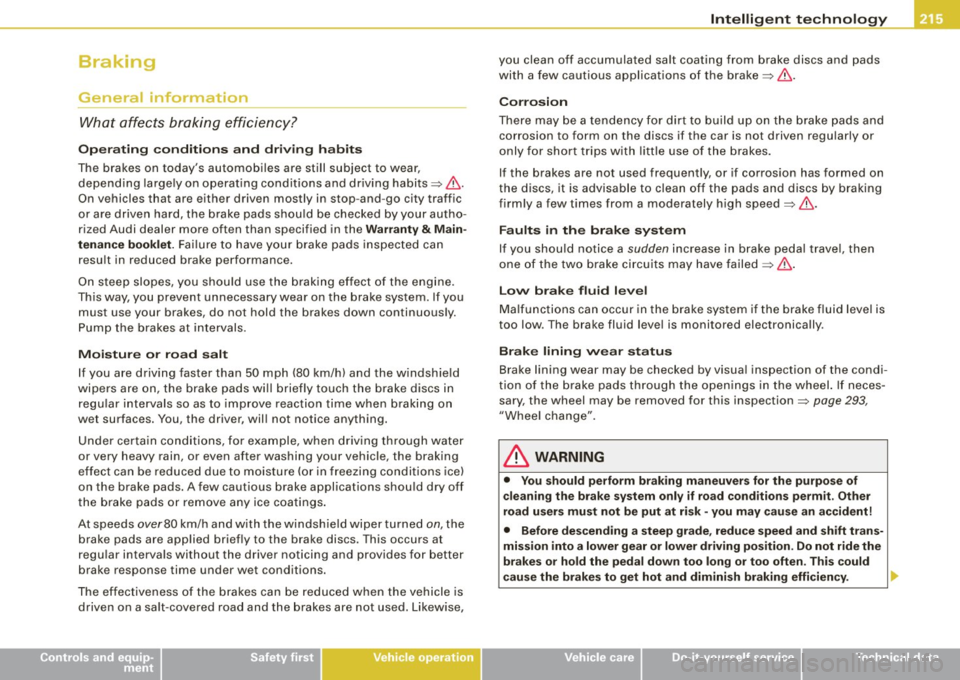
Braking
General information
What affects braking efficiency?
O pera tin g co ndition s and drivi ng h abit s
The brakes on today's automobiles are still subject to wear,
depending large ly on operating conditions and dr iving habits~
&
On vehicles that are either driven mostly in stop -and -go city traffic
or are driven hard, the brake pads shou ld be checked by your autho
rized Audi dealer more often than specified in the
W arr anty & Main
t e nanc e bo okle t.
Fai lure to have you r brake pads inspec ted ca n
resu lt in reduced brake performance.
On steep slopes, you shou ld use the braking effect of the engine.
This way, you prevent unnecessary wear on the brake system. If you must use your brakes, do not hold the brakes down continuous ly.
Pump the brakes at intervals.
Moi sture or road salt
If you are driv ing faster than 50 mph (80 km/h) and the windshie ld
wipers are on, the brake pads wi ll briefly touch the brake discs in
regu lar intervals so as to improve reaction time when braking on
wet surfaces. You, the driver, wil l not notice anything.
Under ce rta in conditions, for example, when dr iving through water
or very heavy rain, or even after washing your vehicle, the braking
effect can be reduced due to moisture (or in freezing conditions ice)
on the brake pads. A few cautious brake applications should dry off
the b rake pads or remove any ice coatings .
At speeds
over80 km/h and with the windshie ld wiper turned on, the
brake pads are app lied briefly to the brake discs. This occurs at
regu lar interva ls wi thout the driver not icing and provides for better
brake response time under wet conditions.
The effectiveness of the brakes can be reduced when the vehicle is driven on a sa lt-covered road and the brakes are not used. Likewise,
Controls and equip
ment Safety first Vehicle operation
Int
ellig ent tec hnol ogy
you clean off accumulated sa lt coating from brake discs and pads
with a few ca utious applications of the brake ~
&-
Cor rosi on
There may be a tendency for dirt to build up on the brake pads and
corrosion to form on the discs if the car is not driven regularly or
only f or sho rt trips with little use of the brakes.
If the brakes are not used frequently, or if corrosion has formed on
the discs, it is advisable to clean off the pads and discs by braking
firm ly a few times from a moderately high speed~
&-
Fa ults in the brake system
If you shou ld notice a sudden increase in brake pedal trave l, then
one of the two brake circuits may have failed~
&-
Lo w brak e fluid l evel
Malfunctions can occur in the brake system i f the brake fluid level is
too low . The brake fluid level is monitored electronically .
Brake lining wear statu s
Brake lining wear may be checked by visua l inspection of the condi
tion o f the brake pads through the open ings in the wheel. If neces
sary, the wheel may be removed for this inspection
~ page 293,
"Whee l change".
& WARNING
• You should perform braking maneuver s for the purpo se of
cl eani ng th e br ake sy stem onl y if ro ad condition s permit . Other
road u se rs mu st not be put a t ris k -you may cau se an accident!
• Before des cending a steep gr ade , reduce sp eed and sh ift tr ans
mi ssion into a lower gear or lower driving po sition . Do not ride the
brake s or hold the pedal d ow n too long or t oo often . This could
cau se the brake s to get hot and dimini sh brakin g efficien cy . _.
Vehicle care Do-it-yourself service Technical data
Page 218 of 340

___ ln_ te_ ll..,,ig ..,_ e_ n_t _t_ e_ c_ h _ n_o _ l_o _,.g= y,_ __________________________________________ _
& WARNING (continued)
• Do not "ride the brakes" by resting your foot on the pedal when
you do not intend to brake. This may cause the brakes to overheat, premature wear and increased stopping distance.
• Under certain climatic and operating conditions such as
passing through water, driving in heavy rain or after washing the
vehicle, the effectiveness of the brakes can be reduced. In winter,
ice can accumulate on the brake pads, linings, discs and drums .
Cautiously apply brakes for a test. Brakes will dry and ice coatings
will be cleaned off after a few cautious brake applications .
• Driving for an extended period of time on salt-covered roads
without using your brakes can also affect braking efficiency. Clean
off accumulated salt coating from brake discs and pads with a few
cautious brake applications.
• If you damage the front spoiler, or if you install a different
spoiler, be sure the air flow to the front brakes is not obstructed.
Otherwise the brake system could overheat reducing the effective
ness of the entire brake system.
• Failure of one brake circuit will impair the braking capability
resulting in an increased stopping distance. Avoid driving the
vehicle and have it towed to the nearest Audi dealer or qualified
workshop. u
Brake booster
The brake booster adds extra braking power.
The brake booster works with vacuum pressure which is created
only when the engine is running~ &.
& WARNING
• Never let the vehicle roll to a stop with the engine shut off.
• If the brake booster is not working, for example when towing
your vehicle, or because the brake booster has somehow been
& WARNING (continued)
damaged, the brake pedal must be pressed considerably harder to
make up for the lack of booster assistance. •
Functioning of Anti-Lock Brake System (ABS)
ABS prevents the wheels from locking up under braking.
The ABS contributes effectively to vehicle control since it prevents
the wheels from
locking when the brakes are applied. This means
that the vehicle remains steerable and is less likely to skid.
With ABS you do not need to pump the brake. Just hold the brake
pedal down.
However , do not expect that the ABS shortens braking distance
under
all circumstances. When driving on gravel or on newly fallen
snow on top of icy surfaces, braking distance may be even longer,
therefore, under these circumstances, it is especially important that
you drive slowly and with great care.
How the ABS system works
An automatic check is made when a speed of about 4 mph (6 km/h)
is reached. When this happens, a pumping noise can be heard.
If an individual wheel begins to rotate too slowly in relation to
vehicle speed and tends to lock, the ABS automatically reduces brake pressure to prevent that wheel from locking.
This automatic adjustment process will cause a
slight vibration of
the brake pedal and some noises to alert you that vehicle speed
must be adapted to existing road and traffic conditions.
& WARNING
Although the ABS is very effective, always remember that braking
capability is limited by tire traction . Always adjust your driving
speed according to the road and traffic conditions. Do not let the .,_
Page 219 of 340
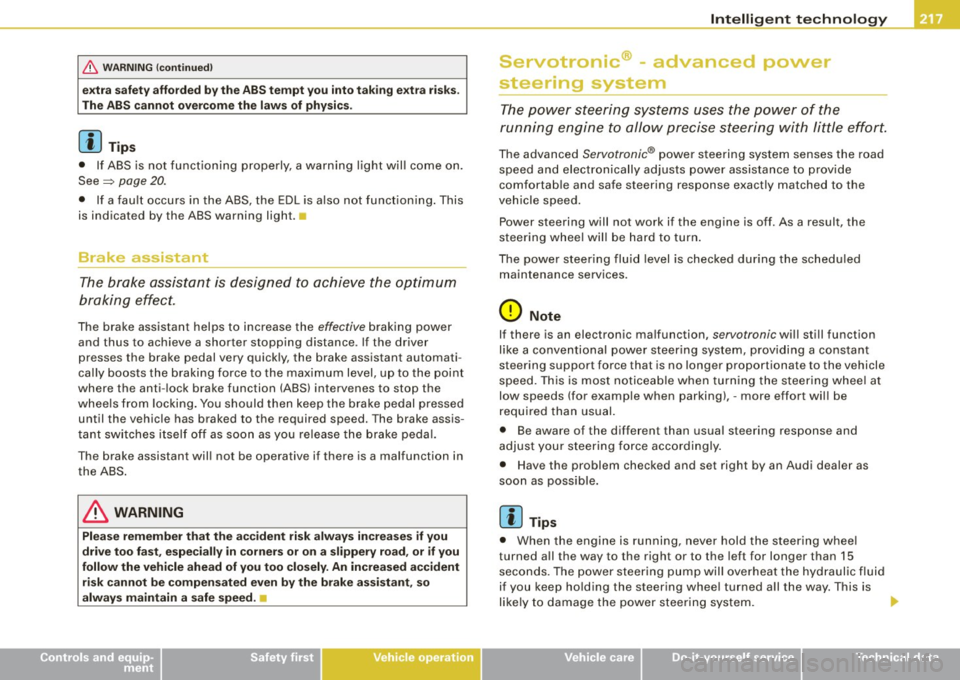
& WARNING (c ont in u ed)
ext ra sa fe ty a fforded by the ABS tempt you into t ak in g ex tr a risks .
The ABS cannot overco me th e law s of ph ysics.
[ i J Tips
• If ABS is not funct ioning properly, a warning light will come on.
See
=> page 20.
• If a fau lt occurs in the ABS, the EDL is also not funct ion ing . This
is indicated by the ABS warning light.
Brake assistant
T he brake assistant is designed to achieve the optimum
braking effect.
The brake assistant helps to increase the effective braking power
and thus to achieve a shorter stopping distance . If the driver
presses the brake pedal very quick ly, the brake assistant automati
cally boosts the braking force to the maximum level, up to the point
where the anti -lock brake function (ABS) intervenes to stop the
wheels from locking. You should then keep the brake pedal pressed until the vehicle has braked to the required speed. The brake assis
tant switches itself off as soon as you re lease the brake peda l.
The brake assistant will not be operative if there is a malfunction in
the ABS .
& WARNING
Please remembe r that the accident risk always in cre a se s if you
dri ve to o fa st, e spe cially in cor ner s o r on a slipp ery road , or if you
follow th e vehicle ahead of you too clos ely. An increased a ccident
ri sk ca nnot be comp en sa ted even b y the brake assista nt , s o
alwa ys maintain a safe spe ed . •
Controls and equip ment Safety first Vehicle operation
Int
ellig ent tec hnol ogy
Servotronic® -advanced power
steering system
The power steering systems uses the power of the
running engine to allow precise steering with little effort.
The advanced Servotronic ® power steering system senses the road
speed and electronically adjusts power assistance to provide
comfortab le and safe steering response exactly matched to the
vehicle speed.
Power steering will not work if the engine is off. As a result, the
steering whee l wil l be hard to turn .
The power steering fluid level is checked during the schedu led
maintenance services.
0 Note
If there is an electronic ma lfunction, servotronic will still function
like a conventional power steer ing system, providing a constant
steering support force that is no longer proportionate to the vehicle
speed. This is most noticeable when tu rning the steering whee l at
low speeds (for examp le when parking), -more effort wil l be
requi red than usual.
• Be aware of the different than usual steering response and
adjust you r steering force accordingly .
• Have the problem checked and set right by an Audi dealer as
soon as possible .
[ i J Tips
• When the engi ne is running, never hold the steering whee l
turned all the way to the right or to the left for longer than 15
seconds. The power steering pu mp will overheat the hydraulic fluid
if you keep holding the steering wheel turned a ll the way. This is
likely to damage the power stee ring system.
~
Vehicle care Do-it-yourself service Technical data
Page 226 of 340
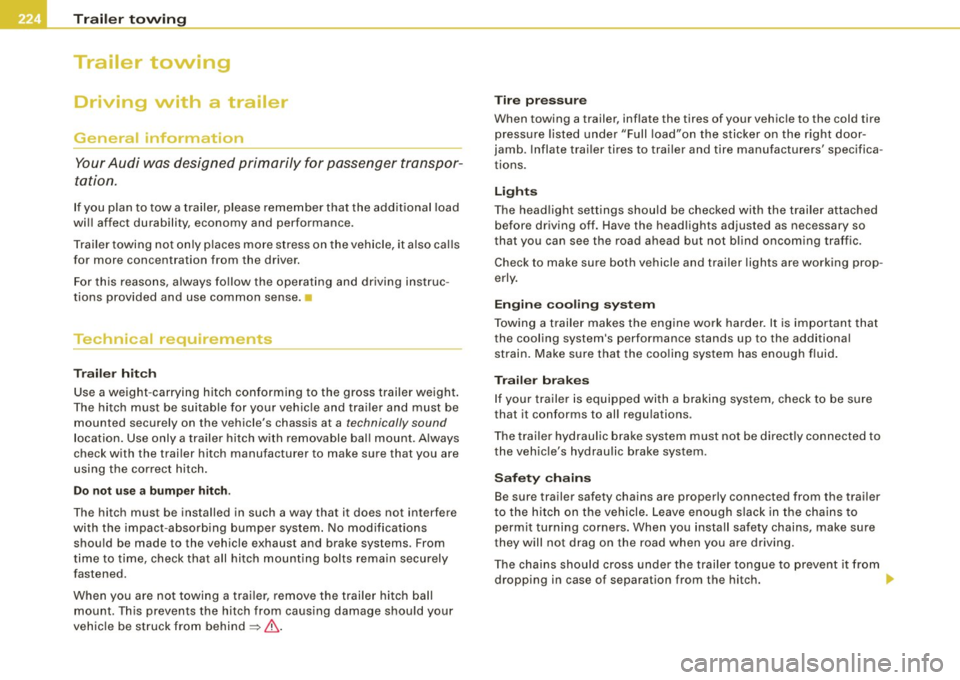
___ T_ r _a_ il_e _r_ t_ o_ vv_ in__... g,_ __________________________________________________ _
Trailer towing
Driving with a trailer
General information
Your Audi was designed primarily for passenger transpor
tation.
If you plan to tow a trailer, please remember that the additional load
will affect durability, economy and performance.
Trailer towing not on ly p laces more stress on the vehicle, it a lso calls
for more concentration from the driver.
For this reasons, always fo llow the operating and driving instruc
tions provided and use common sense. •
Technical requirements
Trailer hitch
Use a weight -carrying hitch conforming to the gross trailer weight.
The hitch must be suitab le for your veh ic le and tra iler and must be
mounted securely on the vehicle's chass is at a technically sound
l ocation. Use only a trailer hitch with removable bal l mount. A lways
check with the trailer hitch manufacturer to make sure that you are
using the correct hitch .
Do not u se a bumper hit ch .
The hitch must be installed in such a way that it does not interfere
with the impact-absorbing bumper system . No modifications
should be made to the vehicle exhaust and brake systems . From
time to time, check that all hitch mount ing bo lts re main securely
fastened.
When you are not towing a trai ler, remove the trailer hitch ball
mount. This prevents the hitch from causing damage shou ld your
vehic le be struck from behind
=:, & .
Tire pre ssur e
When towing a trailer, inflate the tires of your vehic le to the cold tire
pressure listed under "Full load"on the s ticker on the right door
jamb . Inflate trai ler tires to trai ler and tire manufacturers' specifica
tions.
Lights
The head ligh t sett ings should be checked with the trai ler attached
before driving off. Have the head lights adjusted as necessary so
that you can see the road ahead but not blind oncoming traffic.
Check to make sure both vehicle and trailer lights are working prop
erly .
Engine cooling sy stem
Towing a trailer makes the engine work harder. It is important tha t
the cooling system's performance stands up to the additional
strain. Make sure that the coo ling sys tem has enough fluid .
Trailer brakes
If your traile r is equipped wi th a braking system, check to be sure
that it conforms to all regu lations .
The trailer hydraul ic brake system must not be direct ly connected to
the vehic le's hydraulic brake system .
Safety chains
Be sure trailer safety chains are properly connected from the trai ler
to the hitch on the vehicle. Leave enough slack in the chains to
permit turning corners. When you install safety chains, make sure
they will not drag on the road when you are driving.
The chains shou ld cross under the trailer tongue to prevent it from
dropping in case of separation from the hitch.
~
Page 244 of 340

___ C_ le_ a _ n_i_n ~g _ a_ n_ d __ p_r _o _t _e _c_ t_ i_o _n ___________________________________________ _
Safety belts
Only well-maintained safety belts work reliably when
needed.
Heavily soiled safety belts may not retract properly.
- Keep belts clean.
- For cleaning, use a mild soap and water solution. Let
belts dry thoroughly and away from direct sunlight.
- Do not allow inertia reel safety belts to retract before
they are completely dry.
- Check the condit ion of your safety belts
regularly.
& WARNING
Damaged safety belts can break in a crash .
• Anything that might damage your safety belts could mean that
you and your passengers would not be adequately protected in an
accident.
• Safety belt performance depends on correct installation. Never
remove belts from the vehicle to clean them.
• Do not use chemical cleaning agents, bleach or dyes. They have
corrosive properties which weaken the webbing.
• When cleaning your safety belts, inspect them for damage. If
you discover damage, see your Audi dealer.
• Always read and heed all WARNINGS and the information
=:> page 230. •
Engine compartment
Be especially careful when cleaning the engine compart
ment.
Always switch off the ignition before cleaning the engine :::::, &.
Plenum panel
Remove leaves from the plenum panel in front of the windshield
under the engine hood. This prevents the water drain holes from
becoming blocked, and it prevents debris from entering the vehicle
interior through the heating and ventilation ducts.
Corrosion protection
The engine compartment and transmission have been corrosion
protected at the factory.
Good anti-corrosion treatment is very important, particularly in the
winter. If the vehicle is frequently driven on salt treated roads, the
entire engine compartment and plenum panel should be thor
oughly cleaned at the end of winter and retreated to prevent salt
damage. At the same time, the underside of the vehicle should be
washed as well.
I f the engine compartment is cleaned at any time with grease
removing solutions
21 , or if you have the engine washed, the anti
corrosion treatment is almost always removed as well. It is therefore
essential to have a long-lasting corrosion protection reapplied to all
surfaces, seams, joints and components in the engine compart
ment.
& WARNING
Be aware: The engine compartment of any motor vehicle is a
potentially hazardous area.
• Before working in the engine compartment, be sure to read the
information :::::,
page 242. .,.,
21 Use only the correct cleaning solutions. Never use gasoline or diesel fuel.
Page 251 of 340
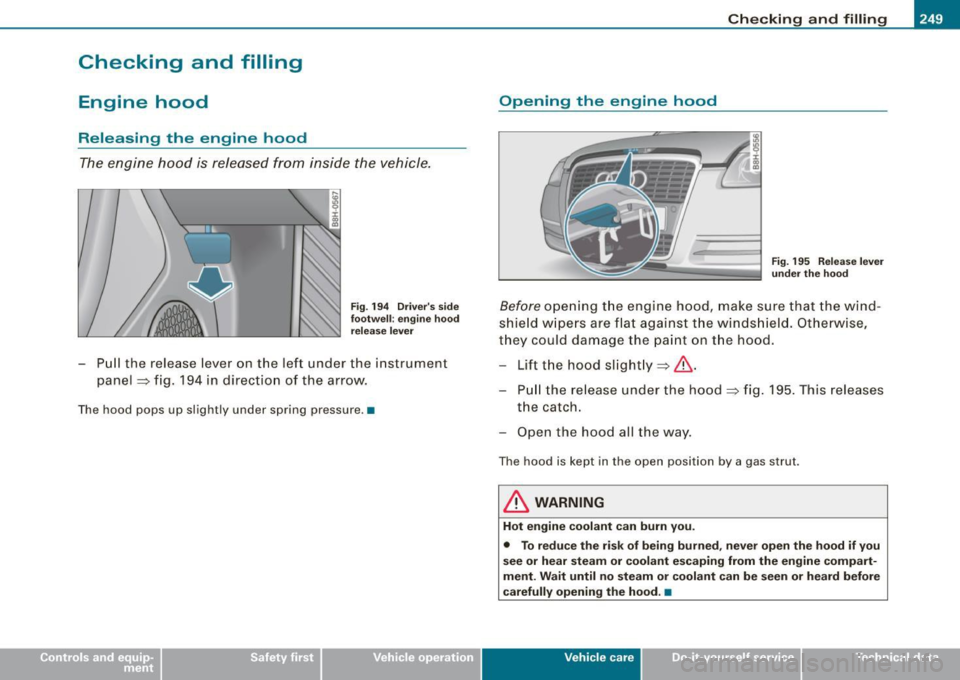
_____________________________________________ C_h_ e_ c _ k_in -= g_a _ n_d _ f_il _li _n """g ;;..._ ____.ffllll
Checking and filling
Engine hood
Releasing the engine hood
The engine hood is released from inside the vehicle.
Fig . 194 Driver's side
footwell: engine hood
release lever
-Pull the release lever on the left under the instrument
panel => fig. 194 in direction of the arrow.
The hood pops up slightly under spring pressure .•
Opening the engine hood
Fig. 195 Release lever
under the hood
Before opening the engine hood, make sure that the wind
shield wipers are flat against the windshield. Otherwise,
they could damage the paint on the hood.
Lift the hood slightly =>& .
- Pull the release under the hood
=> fig. 195. This releases
the catch.
- Open the hood all the way.
The hood is kept in the open position by a gas strut .
& WARNING
Hot engine coolant can burn you .
• To reduce the risk of being burned, never open the hood if you
see or hear steam or coolant escaping from the engine compart
ment. Wait until no steam or coolant can be seen or heard before
carefully opening the hood. •
Vehicle care irechnical data
Page 252 of 340
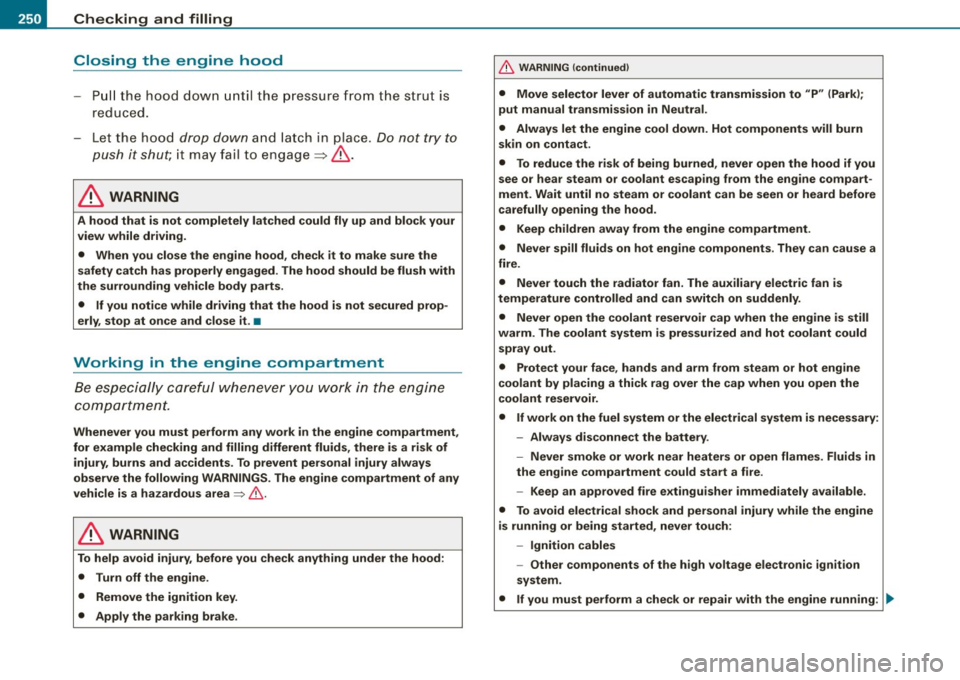
-~_C_ h_e _c _ k_ i_ n ...:::g:;..._ a_n_ d_ f_ i_ll _in ....;g:::;.._ ___________________________________________ _
Closing the engine hood
-Pull t he hood down until the pressure from the strut is
reduced.
- Let t he hood
drop down and latch in place. Do not try to
push it shut;
it may fai l to engage ~& .
& WARNING
A hood that is not completely latched could fly up and block your
view while driving.
• When you close the engine hood, check it to make sure the
safety catch has properly engaged. The hood should be flush with
the surrounding vehicle body parts.
• If you notice while driving that the hood is not secured prop
erly, stop at once and close it. •
Working in the engine compartment
Be especially careful whenever you work in the engine
compartment.
Whenever you must perform any work in the engine compartment,
for example checking and filling different fluids, there is a risk of injury, burns and accidents. To prevent personal injury always
observe the following WARNINGS. The engine compartment of any
vehicle is a hazardous area
~ 6 .
& WARNING
To help avoid injury, before you check anything under the hood :
• Turn off the engine.
• Remove the ignition key.
• Apply the parking brake.
& WARNING (continued)
• Move selector lever of automatic transmission to "P" (Park);
put manual transmission in Neutral.
• Always let the engine cool down. Hot components will burn
skin on contact.
• To reduce the risk of being burned, never open the hood if you
see or hear steam or coolant escaping from the engine compart
ment. Wait until no steam or coolant can be seen or heard before
carefully opening the hood .
• Keep children away from the engine compartment.
• Never spill fluids on hot engine components. They can cause a
fire.
• Never touch the radiator fan. The auxiliary electric fan is
temperature controlled and can switch on suddenly.
• Never open the coolant reservoir cap when the engine is still
warm. The coolant system is pressurized and hot coolant could
spray out.
• Protect your face, hands and arm from steam or hot engine
coolant by placing a thick rag over the cap when you open the
coolant reservoir.
• If work on the fuel system or the electrical system is necessary :
- Always disconnect the battery .
- Never smoke or work near heaters or open flames. Fluids in
the engine compartment could start a fire.
- Keep an approved fire extinguisher immediately available.
• To avoid electrical shock and personal injury while the engine
is running or being started, never touch :
- Ignition cables
- Other components of the high voltage electronic ignition
system.
• If you must perform a check or repair with the engine running:
~
Page 253 of 340
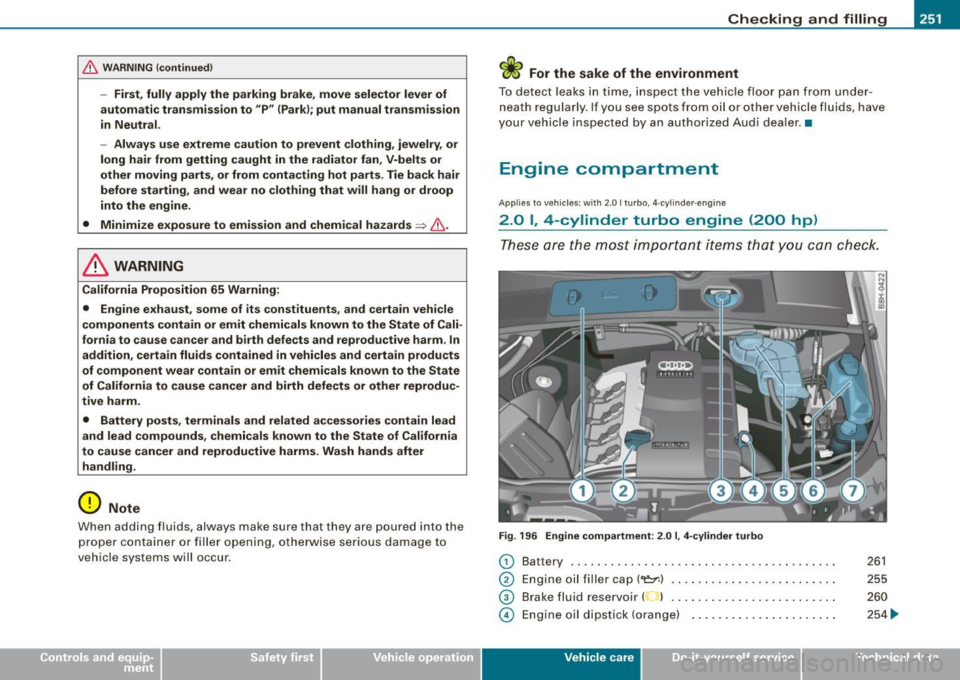
_____________________________________________ C_h_ e.::...::. c.:..k .:..in ;..:.:= g:.....:.; a.:..n :....:d ::....:. f.:.:il .:.:li .:..n :.::g:!-- ----J-
& WARNING (conti nued )
-First , fully apply the parking brake , move selector lever of
automatic transmis sion to "P " (Park) ; put manual transmiss ion
in Neutral.
- Always u se extreme caut ion to prevent clothing, jewelry , or
long hair from getting caught in the radiator fan, V-belts or
other moving parts , or from conta cting hot parts. Tie back hair
before starting , and wear no cloth ing that will hang or droop
into the engine.
• Minimize exposure to emission and chemical hazards
~ & .
& WARNING
California Proposition 65 Warning :
• Engine exhaust , some of its constituents , and certa in vehicle
components contain or emit chemicals known to the State of Cali
fornia to cause cancer and birth defects and reproductive harm . In
addition , certain fluids contained in vehicles and certain produ cts
of component wear contain or emit chemicals known to the State
of California to cause cancer and birth defects or other reproduc
tive ha rm .
• Battery post s, terminals and related acces sories contain lead
and lead compounds , chemicals known to the St ate of California
to cause cancer and reproductive harms. Wash hands after
handling.
0 Note
When adding f luids, always make sure that they are poured into the
p roper container o r filler opening, otherwise se rio us damage to
vehicle systems will occur .
W For the sake of the environment
To detect lea ks i n tim e, inspect t he v ehi cle floor pa n from u nde r
neath regularly. If you see spots from oil or other vehicle fluids, have
y o ur v ehicl e inspected by an author ized Au di dea ler. •
Engine compartment
App lies to veh icles: with 2 .0 I turbo, 4-cylinder •engine
2.0 I , 4-cylinder turbo engine (200 hp )
The se are th e m ost important items that you can check .
Fig. 196 Engine comp art m ent : 2 .0 I, 4-cy lind er turbo
G) Battery ..................................... •..
0 Engine oi l fi lle r ca p ('1:::r.l ..... ... ... ....... .... .. .
© Bra ke fluid reservoir ( ) ..... ... .... ... ... ... .. . .
© Engine oil dipstick (orange) ........ .......... ... .
Vehic le care
N
N
I
261
255
2 60
25 4 ...
irechnical data
Page 254 of 340
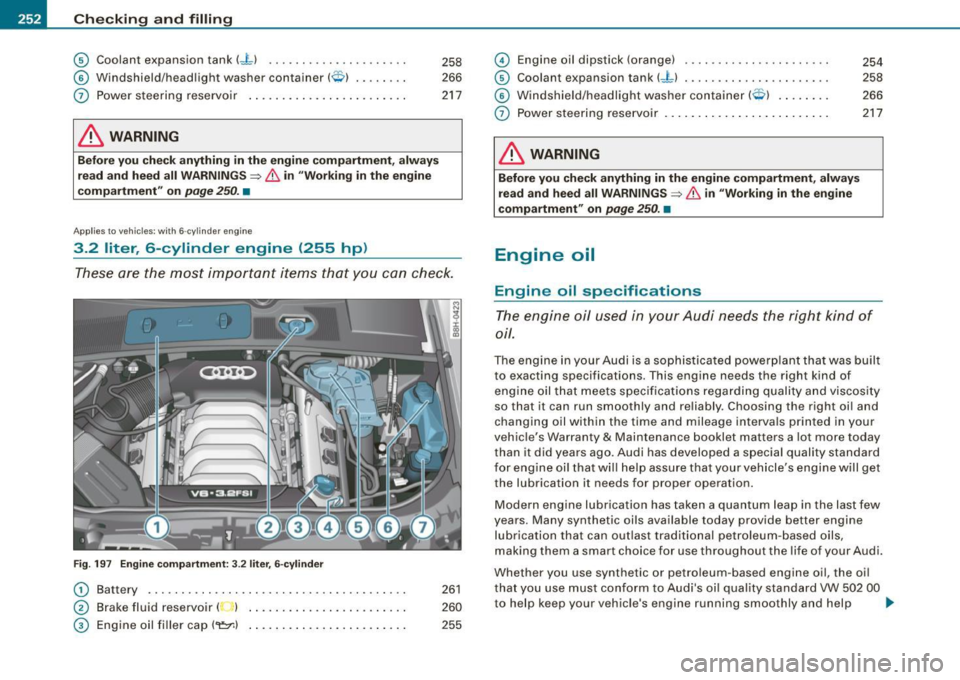
-Ch
ecking and filling
_ _..;:::;__=----------------
©
©
0
Coolant expansion tank (.J_ J .. .. .. .. . ... .. .. .... .
Windshield/head light washer container ( O ) ..... .. .
Po wer steering re servoi r
& WARNING
Before you check anything in the engine compartment , always
read and heed all WARNINGS
=> & in "Working in the engine
c ompartment " on
page 250. •
Applies to veh icles : w ith 6 ·cy lind er engine
3.2 liter , 6-cylinder engine (255 hp)
258
266
217
Th ese a re t he most im por tan t it em s th at you c an ch eck.
F ig . 197 Engine compartment : 3.2 liter , 6- cylinder
G) Battery ... ... .. ...... .... ... .... .... .... ..... .
0 Bra ke fluid reservoir ( l ....... .. .. .. .. ...... .. .
© Engine oil fi ller cap ('t:::n) ..•. ..• ..... .•. ...• ..•..
26 1
260
255
©
©
©
0
Engine oil dipstick (orange) ...... ..... ... .... ... .
Coolant expansion tank
( -L J .. ... ... . .... ... ... .. .
W indshield/headligh t washer c ontainer (O l .. .... . .
Powe r steering rese rvoir
& WARNING
Before you check anything in the engine compartment, always
read and heed all WARNINGS
=> & in "Working in the engine
compartmen t" on
page 250. •
Engine oil
Engine oil specifications
254
258
266
2 17
The engine oil used in your Audi needs the right kind of
oil.
The engi ne in y our Audi is a sophisticated powe rp lan t tha t was built
to exacting specifications. This engine needs the right kind of
eng ine oil that meets specifications regarding quality and viscos ity
so that it can run smoothly and reliably . Choosing the right oil and
changing oil within the time and mileage interva ls printed in your
vehic le's Warranty
& Maintenance booklet matters a lot more today
than it did years ago. Audi has developed a special quality standa rd
f or e ngin e oil tha t w ill help assure that your vehicle's engine will get
the lubrication it needs for proper operation.
Modern engine lubrication has taken a quantum leap i n the last few
years. Many synthetic oils ava ilable today provide better engine
lubrication that can o utlast traditional petro leum -based oil s,
making them a smart choice for use throughout the life of your Audi.
Whether you use synthetic or petro leum -based engine oil, the oi l
tha t you use mus t conform to Audi 's oi l qual ity standard VW 502 00
to help keep your vehicle's engine running smoothly and help ._
Page 255 of 340
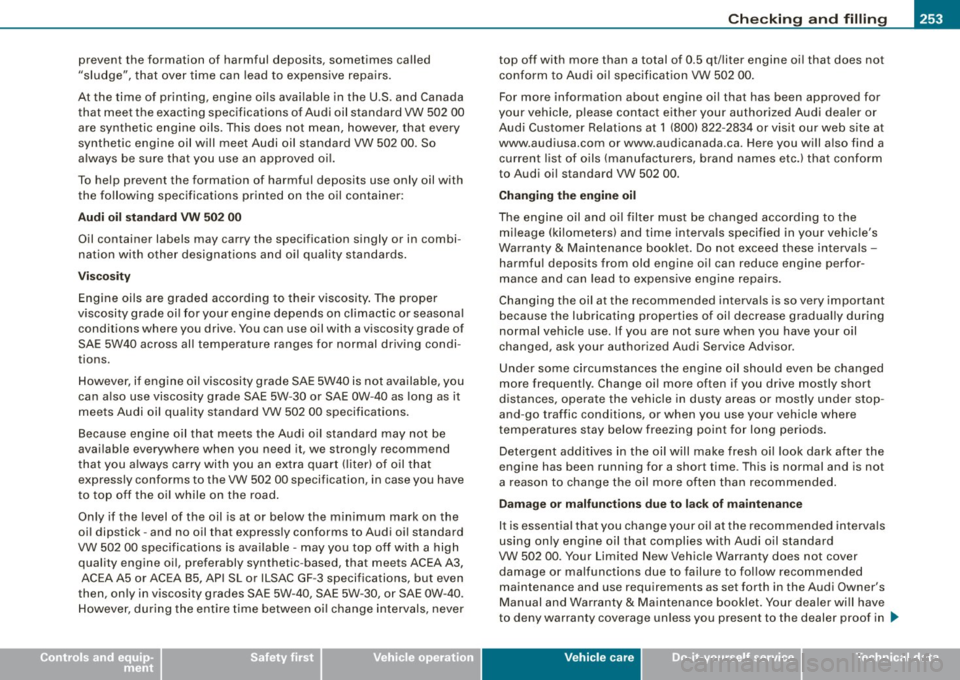
Checkin g a nd fillin g -
-----------------=-------"=--------
•
prevent the formation of harmful deposits, sometimes called
"sludge", that over time can lead to expensive repairs.
At the time of printing, engine oi ls available in the U.S . and Canada
that meet the exacting specifications of Audi oil standard VW 502 00
are synthetic engine oils. This does not mean, however, that every
synthetic engine oil will meet Audi oil standard VW 502 00. So
always be sure that you use an approved oil.
To help prevent the formation of harmful deposits use only oil with
the fo llowing specifications pr inted on the oil container:
A ud i oil stan dard VW 50 2 0 0
Oil container labels may carry the specification singly or in combi
nation with other designations and oil quality standards.
V isc osi ty
Engine oils are graded according to their viscosity . The proper
viscosity grade oil for your engine depends on climactic or seasona l
conditions where you drive. You can use oil with a viscosity grade of
SAE 5W40 across all temperature ranges for normal dr iving condi
tions.
However, if engine oil viscosity grade SAE 5W40 is not available, you
can a lso use viscosity grade SAE 5W-30 or SAE 0W-40 as long as it
meets Audi oil qua lity standard VW 502 00 specifications .
Because engine oil that meets the Audi oil standard may not be
avai lable everywhere when you need it, we strongly recommend
t hat you a lways carry with you an extra quart ( liter) of oil that
express ly conforms to the VW 502 00 specification, in case you have
t o top off the oil while on the road .
On ly if the level of the oil is at or be low the minimum mark on the
oi l dipstick -and no oil that express ly conforms to Audi oil standard
VW 502 00 specifications is available -may you top off with a high
quality engine oil, preferably synthetic -based, that meets ACEA A3,
ACEA A5 or ACEA B5, API S L or ILSAC GF -3 specifications, but even
then, on ly in viscosity grades SAE 5W -40, SAE 5W -30, or SAE 0W -40.
However, during the ent ire time between oi l change intervals, never top off with more than a total of 0
.5 qt/ liter engine oi l that does not
conform to Audi oil specification VW 502 00.
For more information about engine oi l that has been approved for
your vehicle, p lease contact either your authorized Audi dea ler or
Audi Customer Relations at 1 (800) 822-2834 or visit our web site at
www.audiusa.com or www.audicanada.ca. Here you will also find a current list of o ils (manufacture rs, brand names etc.) that confo rm
to Audi oil standard VW 502 00.
Changing th e engine oil
The engine oil and oil f ilter must be changed according to the
mi leage (ki lometers) and time intervals specified in your vehic le's
Warranty & Maintenance booklet. Do no t exceed these intervals -
harmfu l deposits from old engine oil can reduce engine perfor
mance and can lead to expensive eng ine repa irs.
Changing the oil at the recommended intervals is so very important
because the l ubricating properties of oi l decrease gradua lly during
norma l vehicle use. If you are not sure when you have your oil
changed, as k your authorized Audi Service Advisor.
Under so me circumstances the engine oil should even be changed
more frequently . Change oil more often if you drive mostly short
distances, opera te the vehicle in dusty areas or m ostly under stop
and-go traffic conditions, or when you use your vehicle where
temperatures stay below freezing point for long periods .
Detergent additives in the oil will make fresh oil look dark after the
engine has been running for a short time. This is normal and is not
a reason to change the oil more often than recommended.
D amag e or malf unct ions due to la ck of maintenan ce
It is essential that you change your oi l at the recommended intervals
using on ly engine oil that complies with Audi oil standard
VW 502 00. Your Limited New Vehic le Warranty does not cover
damage or malfunctions due to failure to fol low recommended
maintenance and use requirements as set forth in the Audi Owner's
Manual and Wa rranty & Maintenance booklet. Your dea ler wi ll have
to deny warranty coverage unless you present to the dealer proof in _,.
Vehic le care